How Gyrocompasses Work + Corrections to Earlier Videos
▶️Watch on 3Speak - Odysee - BitChute - Rumble - DTube - YouTube - PDF notes
In this video I go over how a gyrocompass works, my own unique explanation of gyroscopic precession, and several corrections to my earlier videos. A gyrocompass is just a spinning wheel with 2 degrees of freedom and a mechanism to induce precession as the Earth rotates, thus allowing it to detect True North. Compare this with a gyroscope that has 3 degrees of freedom. Gyroscopes have 2 main properties: rigidity in space and precession, which is the change of direction of its spin axis.
In mainstream physics, precession is explained by the right hand rule: curl your right hand along the direction of the gyro spin with thumb pointing outwards, do the same for the applied torque, and the direction of precession follows the vector sum of the directions of the thumbs. In MES physics, I explain precession as the gyro spin and applied torques want to line up with each other, and that precession itself is a torque that can cause the gyro to rise upwards against gravity.
Gyrocompasses require an additional precession mechanism because the Earth rotates very slowly, so friction in the bearings typically can overcome precession due to Earth's rotation alone. One mechanism of inducing precession is by attaching a mercury tube to the gyro such that as the gyro lifts the tube due to its rigidity in space, the liquid mercury flows to the opposite side. This induces precession such that the gyro will spin opposite of Earth's rotation. Another mechanism is by simply adding a weight to the bottom of the gyrocompass: as the gyro lifts the weight, there is a downwards force by the weight that induces precession such that the gyrocompass aligns in the same direction as Earth's rotation.
Further in the video, I clarify some errors I made in my previous videos. The gyrocompass explanation image I showed previously was actually correct and my edits were wrong. The compensator weights in the WW2 gyrocompass video I went over were used to balance the weight of the gyro and not to induce precession; it too used a mercury tube setup which they referred to as a "mercury ballistic".
Timestamps:
- Intro: 0:00
- MES Note: 0:33
- Topics to Cover: 1:19
- How Gyrocompasses Work: 1:41
- Gyroscope Properties: 4:22
- Rigidity in Space: 4:32
- Precession: 7:33
- Gyroscopes want to line up with applied torques: 18:20
- Important Note: High spin speeds overcome small torques: 22:22
- How Gyrocompasses Detect True North: 24:51
- Debunking Flat Earth high friction gyrocompass: 27:07
- Mechanism to induce precession: Mercury Tube: 31:41
- Adding a weight to induce precession: 37:53
- Further Corrections to my earlier videos: 40:49
- Outro: 43:29
View Video Notes Below!
Become a MES Super Fan
Donate
Subscribe via email
MES merchandise
MES Links
Follow my research in real-time on my MES Links Telegram
MES TruthReuse of my videos:
- Feel free to make use of / re-upload / monetize my videos as long as you provide a link to the original video.
Fight back against censorship:
- Bookmark sites/channels/accounts and check periodically.
- Remember to always archive website pages in case they get deleted/changed.
Recommended Books:
- "Where Did the Towers Go?" by Dr. Judy Wood
Join my forums: Hive community - Reddit - Discord
Follow along my epic video series: MES Science - MES Experiments - Anti-Gravity (MES Duality) - Free Energy - PG
NOTE 1: If you don't have time to watch this whole video:
- Skip to the end for Summary and Conclusions (if available)
- Play this video at a faster speed.
-- TOP SECRET LIFE HACK: Your brain gets used to faster speed!
-- MES tutorial- Download and read video notes.
- Read notes on the Hive blockchain $HIVE
- Watch the video in parts.
-- Timestamps of all parts are in the description.Browser extension recommendations: Increase video speed - Increase video audio - Text to speech (Android app) – Archive webpages
How Gyrocompasses Work + Corrections to Earlier Videos
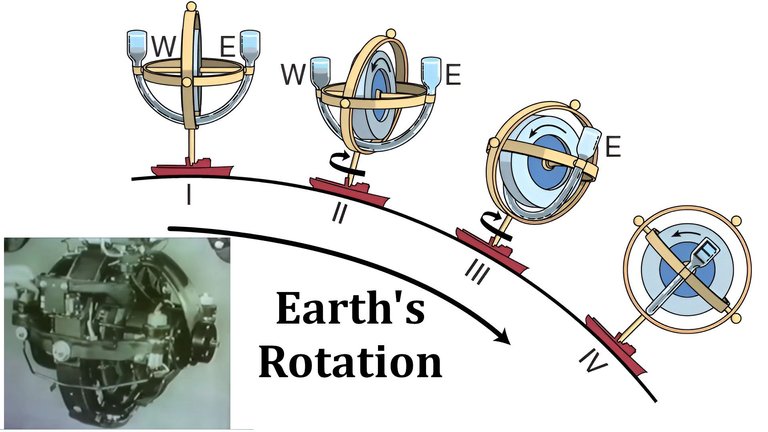
MES Note
I started doing Debunking Flat Earth videos and the first videos were on the gyrocompass.
After making those videos, I realized that I made some slight errors regarding gyrocompasses so I will clarify those here.
Note also that I will update the relevant video playlists to include this correction, and those can be seen on MES Links: https://mes.fm/links
Topics to Cover
- How Gyrocompasses Work
- Gyroscope Properties
- Rigidity in Space
- Precession
- Important Note: High Spin Speeds Overcome Small Torques
- How Gyrocompasses Detect True North
- Further Corrections to My Earlier Videos
How Gyrocompasses Work
A gyrocompass is a spinning wheel with 2 degrees of freedom and a mechanism to induce precession to determine True North (or geographic north). A gyroscope is a spinning wheel with 3 degrees of freedom.
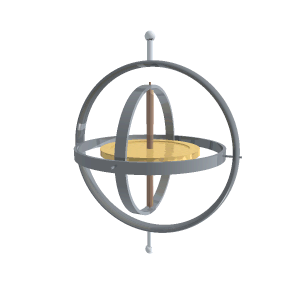
GIF: Free gyroscope can be rotated about 3 different axis.
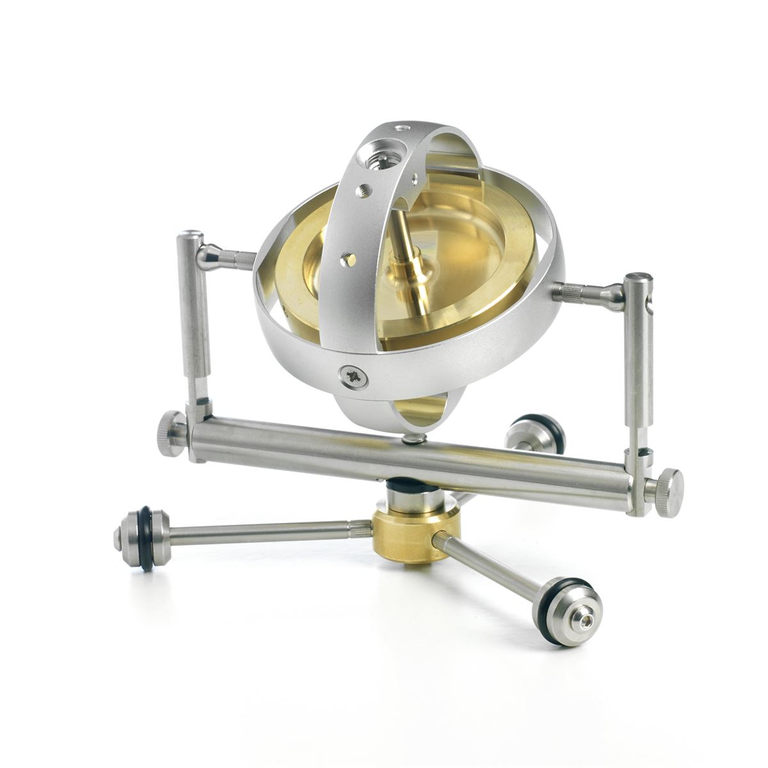
Image: A spinning wheel with 2 degrees of freedom instead of 3. Technically this is a gyrocompass but this doesn't have a mechanism to induce precession.
Gyroscope Properties
Gyroscopes have 2 main properties:
- Rigidity in space
- Precession
Rigidity in Space
Gyroscopes want to maintain their orientation when torqued. Torque is a "rotational force" or pair of forces that cause a turning motion.
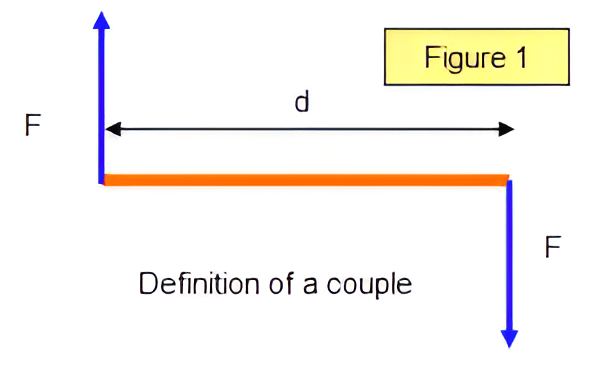
Image: Torque as a force-couple.

Image: Torquing a car tire nut.
Here is a demonstration of a gyroscope resisting changes in its orientation.
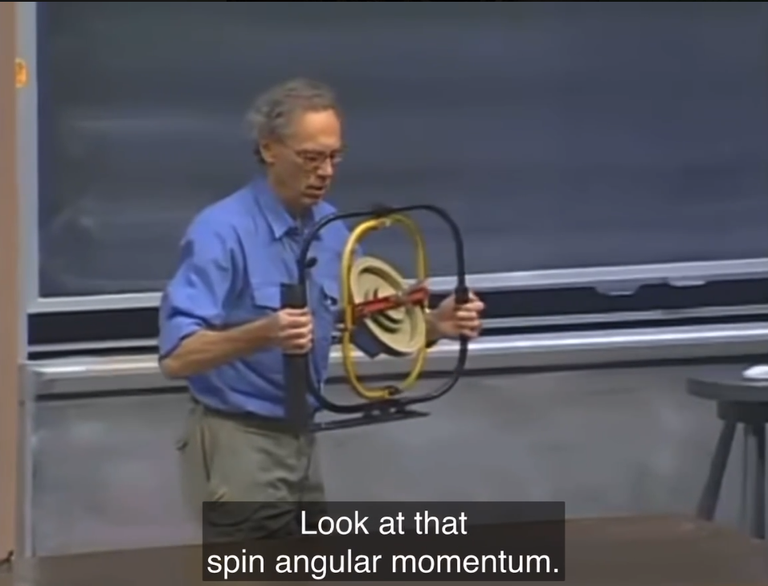
Video: Gyroscope demonstration by Professor Walter Lewin
Precession
Precession is a change of the rotational axis of a rotating object.
In mainstream physics, precession is explained by the Right Hand Rule.
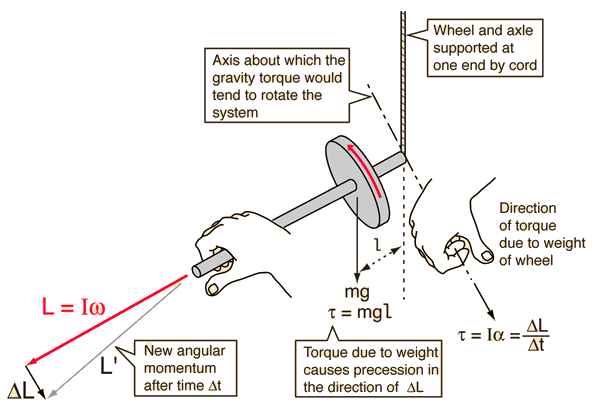
Image: A spinning wheel precesses in the direction as per the right hand rule.

GIF: Mainstream demonstration of precession that ignores friction at the base or gyroscopes rising on their own.
In MES physics, precession is explained as the spin and applied torques wanting to line up with each other, even if it means rising against gravity.
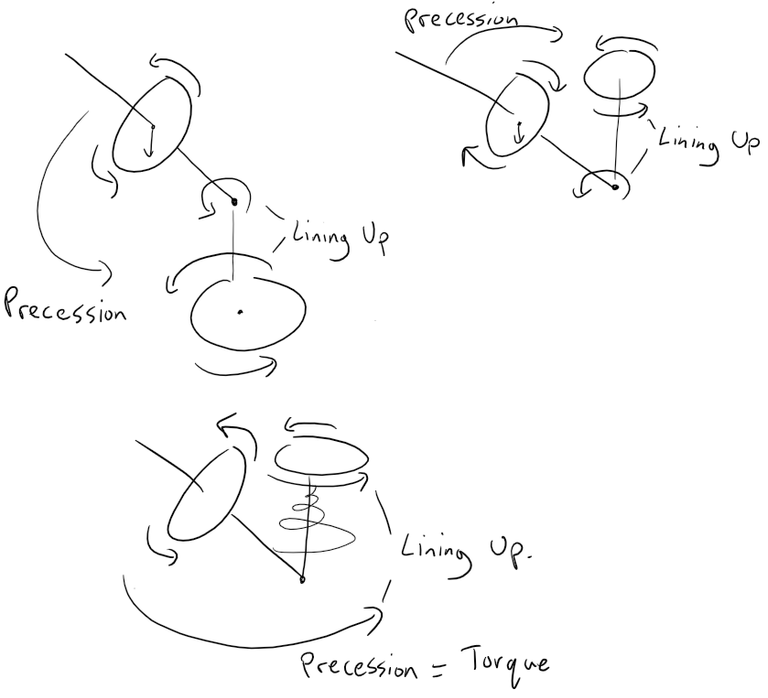
This is demonstrated in the following experiment, which shows the downwards torque causing precession in the counterclockwise direction (since the gyro is also spinning counterclockwise), and precession itself acts as a torque to keep the gyroscope upright and rising. Again, all this until the gyroscope lines up with precession / applied torque.
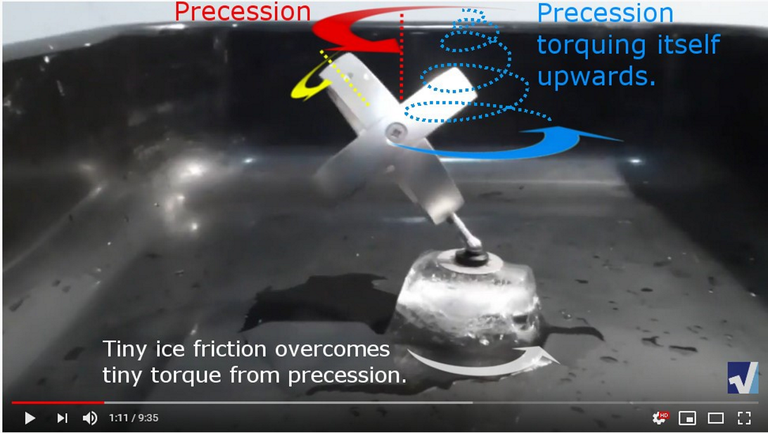
MES Experiment 5: Gyroscopes precess upwards on ice with zero centripetal force.
Further demonstrations can be seen in a gyrocompass-type setup: https://youtu.be/1kOL6qQf6I0

Torquing the gyro will cause it to want to align spin and torque directions.
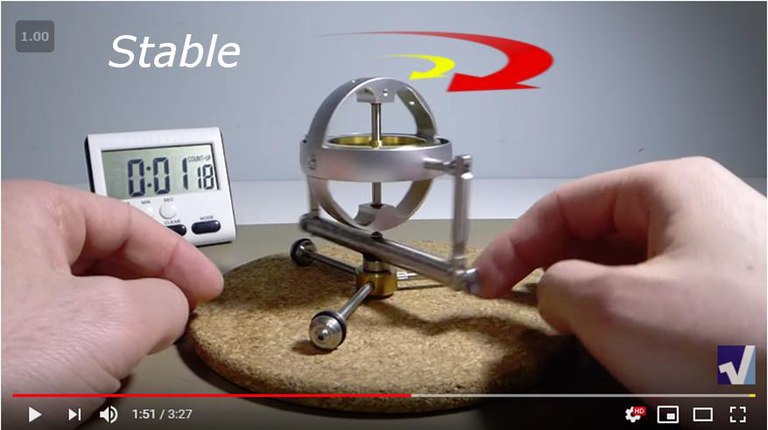
Torquing in the direction of spin is stable.
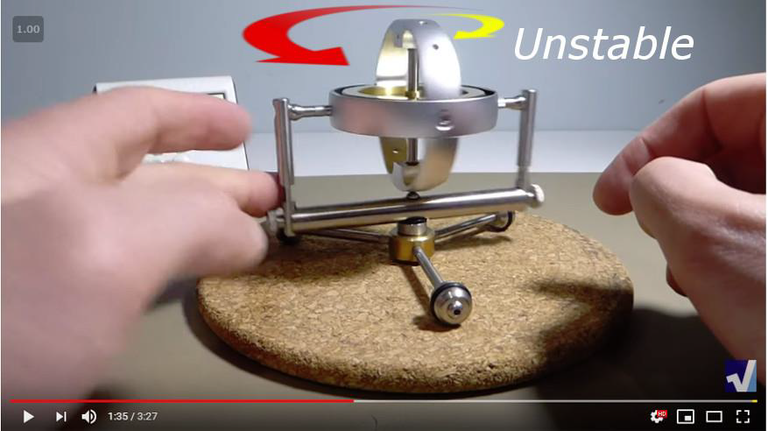
Torquing in the opposite direction of spin is unstable and any deviations from horizontal will induce precession and cause the gyro to flip upside down.
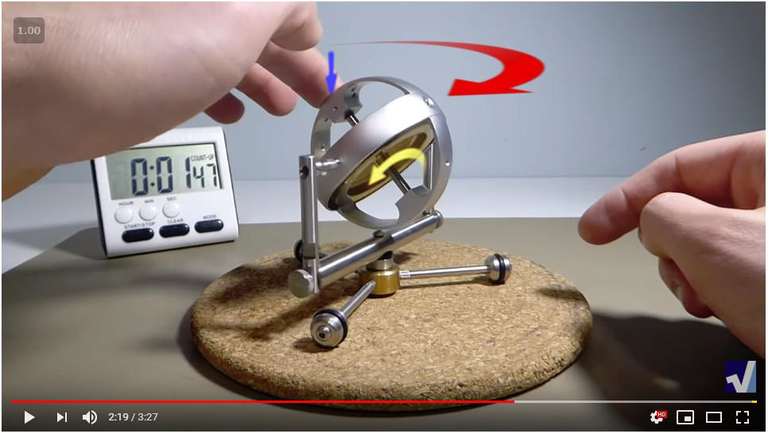
Pushing the gyro down will cause it to precess so that it spins downwards.
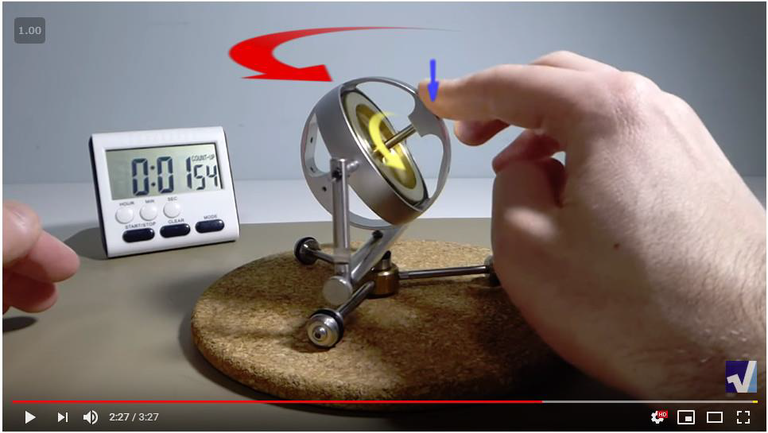
Once the gyro tilts so that it flips over, a downwards force reverses precession direction, but still wanting to align spin and precession directions.
Important Note: High Spin Speeds Overcome Small Torques
Note that in the case of the free gyroscope with 3 degrees of rotational freedom, the bearings provide very little torque hence the gyroscope will barely precess as the casings are turned.
If a gyroscope is spinning fast, then the gyro will precess slowly.
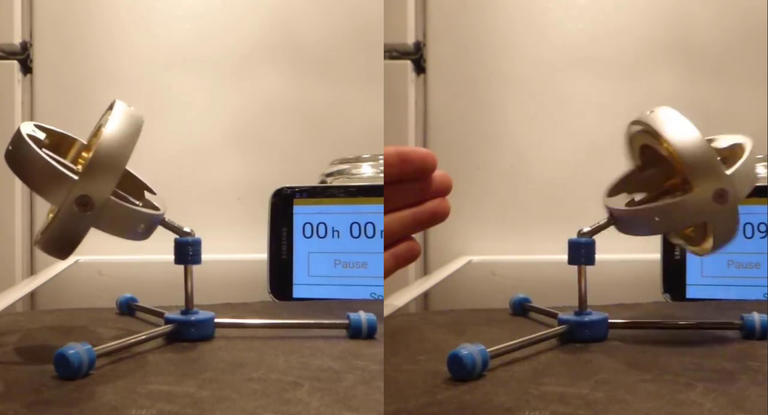
MES Experiment 2: The gyroscope on the left is spinning fast and precessing slow. The gyroscope on the right is spinning slow but precessing fast.
Theoretically, if a gyroscope is spinning VERY fast, then it will appear to be not precessing at all. Thus, even the gyro spinning top above will act like a free gyroscope.
How Gyrocompasses Detect True North
Theoretically, a gyrocompass can detect True North without any additional mechanisms to induce precession since gyroscopes want to align with applied torques.
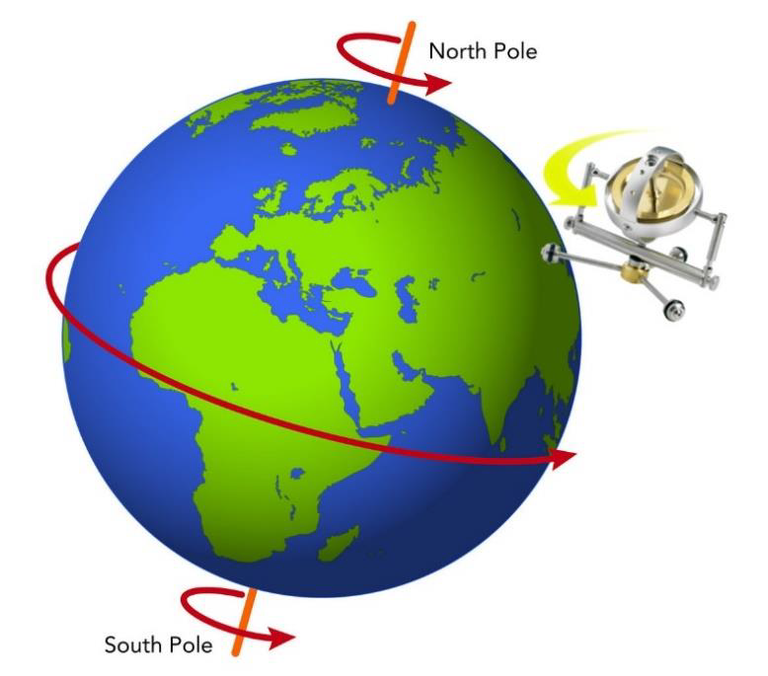
Image: Theoretical gyrocompass without additional mechanisms to induce precession.

MES Experiment 31: Theoretical gyrocompasses with only 1 degree of freedom.
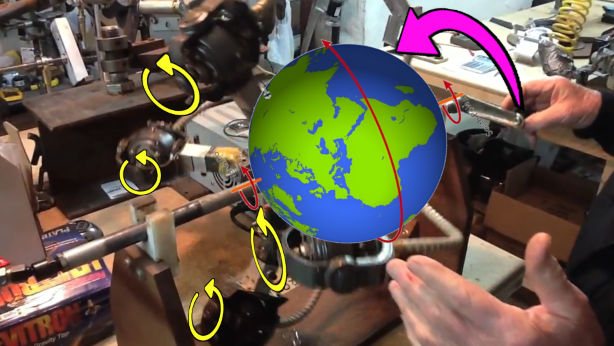
Video: Theoretical gyrocompasses with Earth imposed in between.
But since Earth rotates very slowly, the induced precession would either be incredibly slow or too small to overcome friction and other constraints. And certainly not basic store bought gyrocompass-like setups with direct metal to metal supports with NO bearings, as these Flat Earth disinfo agents would have you believe…
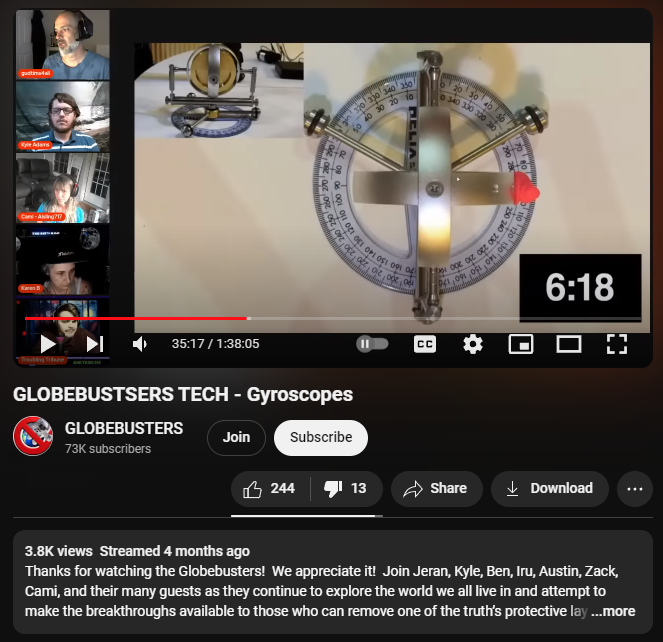
Video: Flat Earth disinfo agents discussing a useless "gyrocompass" experiment with high friction connections that would be able to detect Earth's rotation even if it was 1000 times faster (literally).
Here is a demonstration of the same "gyrocompass" as above and showing that it can't detect slow rotations (since static friction is higher than dynamic friction).
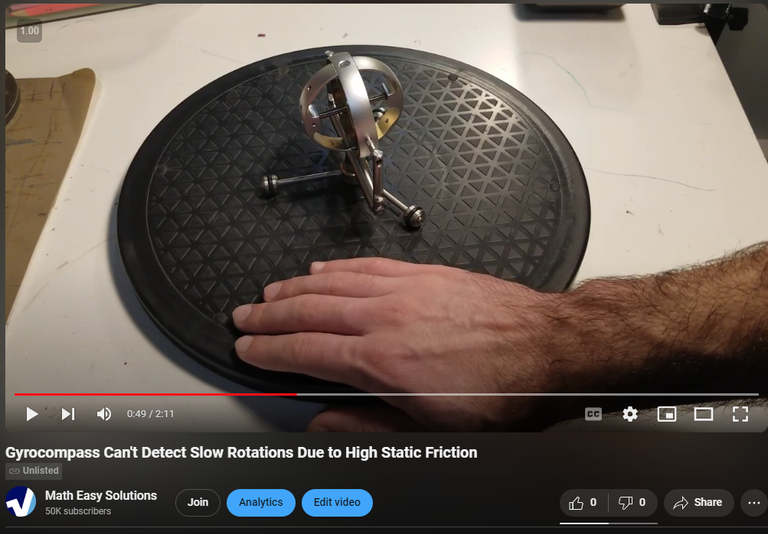
Video: Gyrocompass Can't Detect Slow Rotations Due to High Static Friction
My above gyrocompass couldn't detect a rotation of 1 revolution per 2 minutes (rough estimate). Compare that with Earth's rotation:
1 revolution per 24 hours.
10X faster is 1 revolution per 2.4 hours.
100X faster is 1 revolution per 0.24 hours = 0.24*60 = 14.4 minutes.
1000X faster is 1.44 minutes which is just faster than our slow rotation!
Thus there needs to be an additional mechanism to induce precession and speed up the gyro alignment with the rotation of the Earth; or alternatively produce literally frictionless bearings.
One such method is to add a tube of mercury that shifts its position as the gyrocompass lifts the tube trying to maintain orientation.
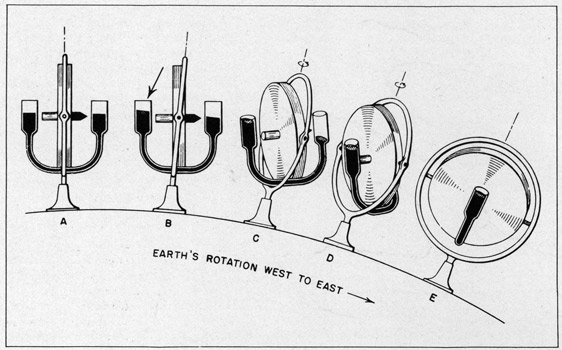
Image: The mercury causes a downwards force on the left side, thus causing precession such that spin lines up with the downwards force. Thus, in this case the gyro rotates counterclockwise and OPPOSITE of Earth's rotation.
The following image shows a gyrocompass with and without the mercury tube. Note that this image is indeed CORRECT and that the image I used in my earlier videos is WRONG. And the gyrocompass without the tube is NOT a free gyroscope as I incorrectly stated before.
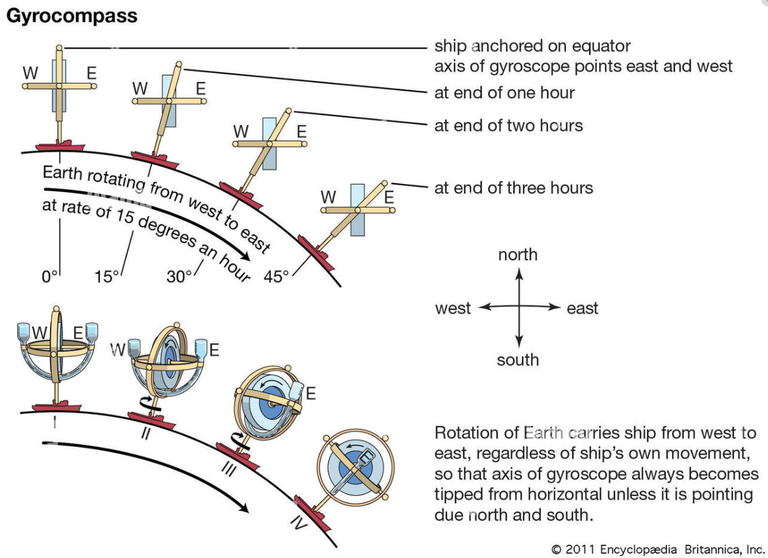
Image: Gyrocompass without the mercury tube wants to maintain orientation (above). Gyrocompass with a mercury tube wants to align OPPOSITE of Earth's rotation.
Alternatively, adding a weight at the bottom of the gyrocompass will torque it downwards such that the gyro will precess to align WITH Earth's rotation.
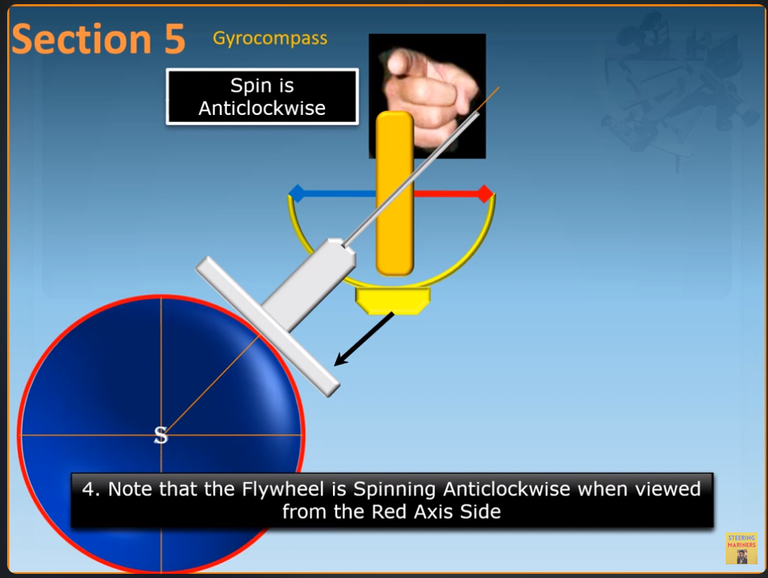
Video: Inducing precession in a gyrocompass by adding a weight at the bottom causes the gyrocompass to align in the direction of the Earth's rotation.
This is pretty much how a gyrocompass works, but further technical operating details can be found at the Steering Mariners YouTube channel.
Further Corrections to My Earlier Videos
As stated earlier, here the image I used to explain gyrocompasses that has my WRONG "corrections" applied to it.
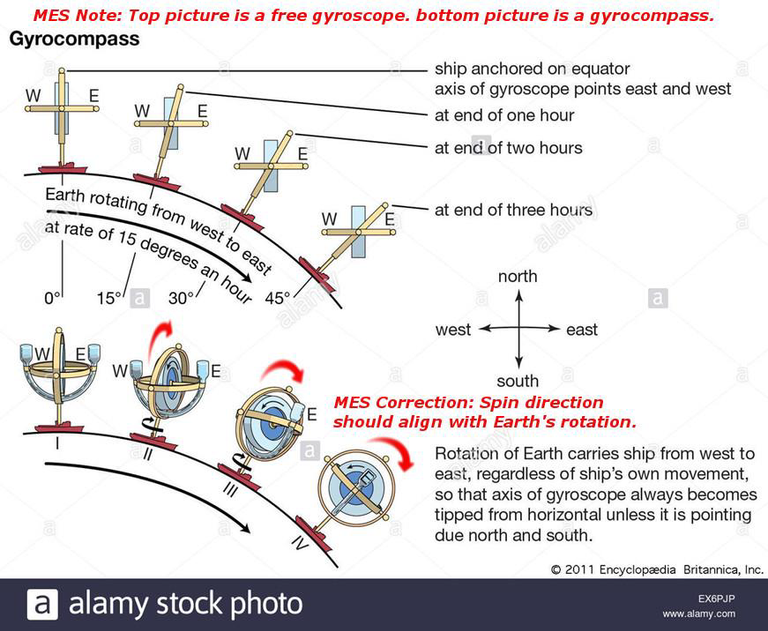
Image: The MES Notes in red are WRONG. The unedited photo is correct to show the gyrocompass aligns opposite of Earth's rotation.
Another error I made in my earlier videos was stating that the compensator weights on the WW2 gyrocompass were what induced precession. This is WRONG. The compensator weights are just as the name states, they are added to compensate for the weight imbalance to ensure the gyro assembly is perfectly balanced by weight. This gyrocompass used mercury tubes as well to induce precession.
Design of the Sperry Mk XIV Gyro-Compass: https://youtu.be/EM051IXJD9Q
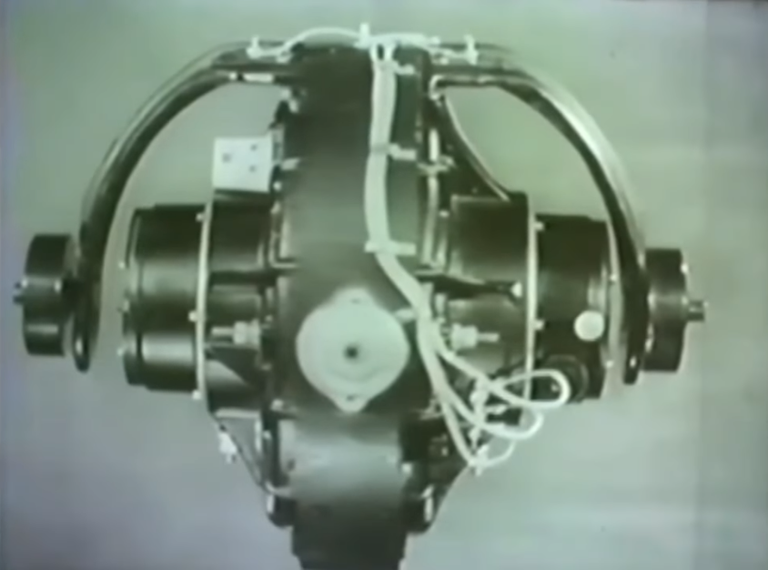
Compensator weights to balance the weight of the gyrocompass.
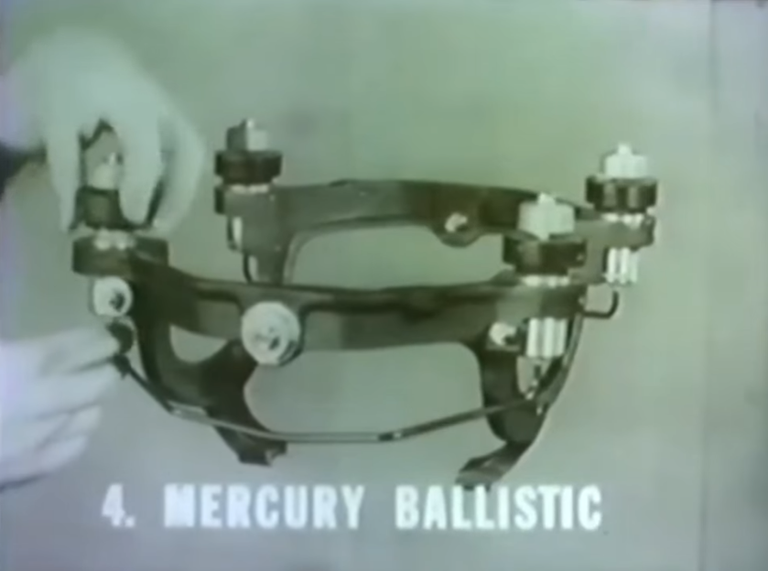
Two Mercury tubes attached to the gyrocompass to induce precession.
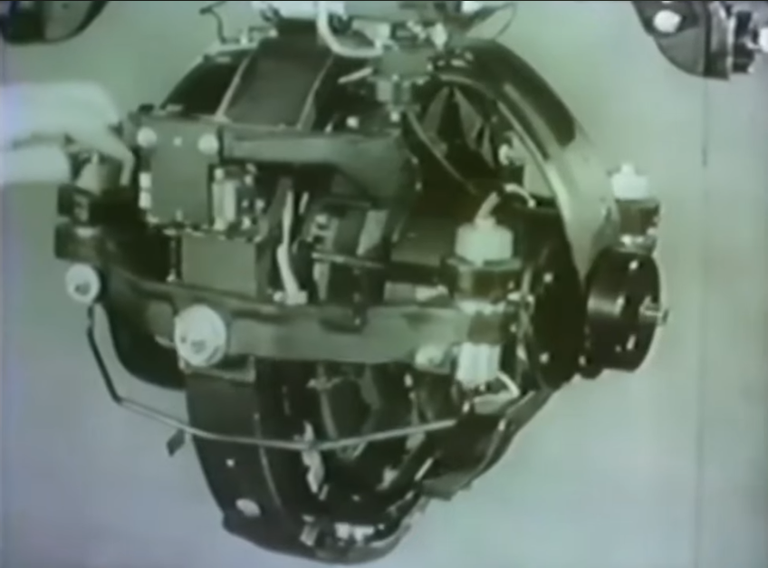
Mercury Tubes shown in the complete gyrocompass assembly.
Thanks for your contribution to the STEMsocial community. Feel free to join us on discord to get to know the rest of us!
Please consider delegating to the @stemsocial account (85% of the curation rewards are returned).
You may also include @stemsocial as a beneficiary of the rewards of this post to get a stronger support.